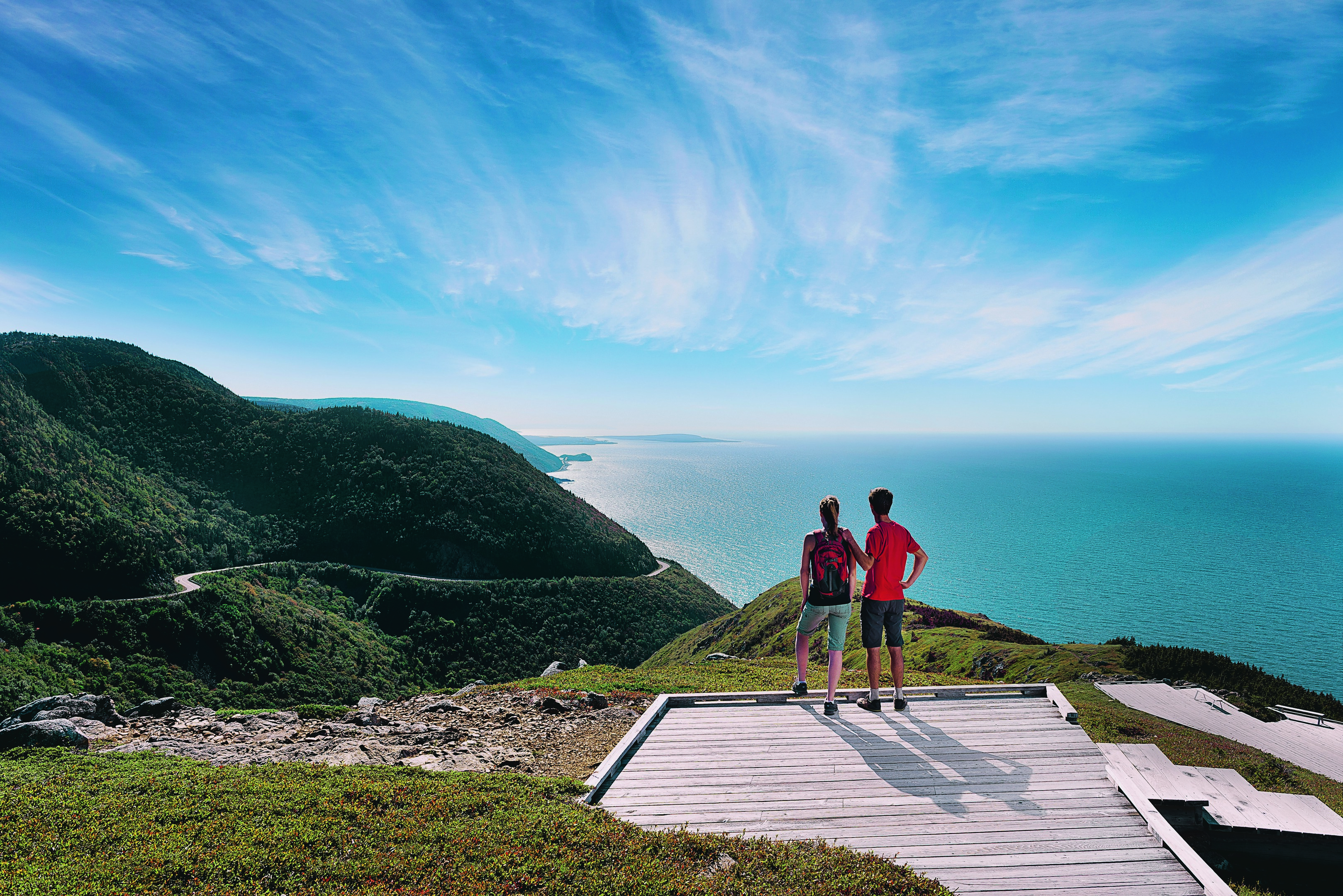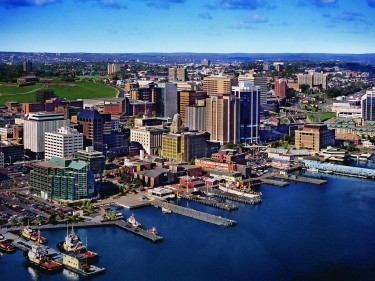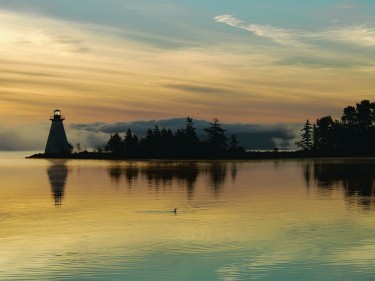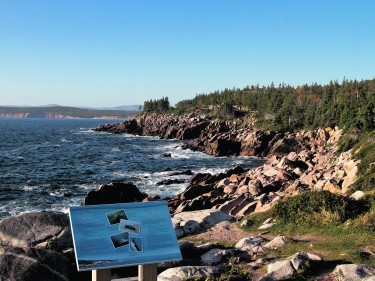Susan Welsh goes ceilidhing along Cape Breton’s Cabot Trail in Nova Scotia and discovers a beautiful place which celebrates its Celtic roots
As the Icelandair plane swooped low over Halifax, Nova Scotia, from my window all I could see were acres of trees. The short drive from the airport to the vibrant coastal city also left me in no doubt that I’d arrived in a country where there’s no shortage of lumber and made it easy to see why so many of the homes, often brightly painted, are made of wood cut from trees so tall you’ll hurt your neck trying to see the tops.
With lochs and mountains, swathes of forest and lots of wide open spaces, Canada looks a lot like Scotland, but on a much grander scale, and with thousands of Gaelic speakers, Celtic music being played in pubs and restaurants and towns with well-kent names including Inverness, Aberdeen and Glasgow, it really does feel familiar. As for the warm welcome you get when they twig you are Scottish, well the locals really do open their hearts and arms to you.
An excellent starting point is the Canadian Museum of Immigration at Pier 21, which is part of the Halifax Waterfront, a fantastic boardwalked area, overlooking the working port, and home to numerous restaurants, bars, art works and museums. Pier 21 was the gateway which more than a million people, all filled with hope, came through between 1928 and 1971. It was also the last place 500,000 military personnel saw before leaving to fight in World War II. Some of their stories, often deeply moving, are told here.
Just a short walk away is another museum where you may shed a tear, the Maritime Museum of the Atlantic, home to the world’s finest collection of wooden artefacts from the Titanic. Until visiting, I hadn’t realised Halifax was the closest port to the 1912 tragedy and where much of the wreckage and many bodies were brought. Among the fascinating exhibits were photographs showing the harbourside lined with coffins. Even in death, the class system operated with bodies of steerage and second-class passengers placed in canvas bags, with wealthier passengers getting wooden coffins.
Around 150 Titanic victims are buried in three city cemeteries, most with granite headstones paid for by the White Star Line. A steady stream of visitors head to Fairview Lawn Cemetery to pay their respects at the grave of John Law Hume. A 21-year-old from Dumfries, he played his violin as the liner sank below the icy waters and died unaware that his fiancee was expecting their first child. His bravery has never been forgotten and today, there’s always a violin and fresh flowers on his grave.
The Halifax Citadel, aka Fort George, a fort hidden within a hilltop overlooking the city, is also worth visiting. First established in 1749, it’s been used for generations to defend the city from a variety of enemies. Today, it is run by Park Canada and restored to the Victorian period. Actors dressed as members of the 78th (Highlanders) Regiment of Foot and the 78th Highlanders (Halifax Citadel) Pipe Band who were stationed there for three years, help give the impression that you’ve stepped back in time.
Halifax is a fairly compact city and easily discovered on foot. Just don’t make the mistake I did of standing on a street corner, map in hand, dithering about which direction to take. Pedestrians rule here, and traffic drives slowly through the city. By standing on the pavement edge looking like I wanted to cross, I’d stopped all the traffic but was unaware of this until one patient driver rolled down his window and politely asked if I intended to move. Oops.
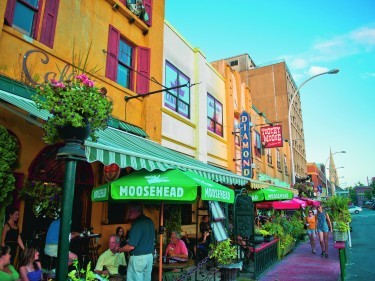
EN ROUTE TO PICTOU
Having picked up a rental car, I left the city and headed for Pictou. The main roads are wide but it’s not until you start driving you realise what a huge country this is. What seems like a short distance can be a long way off, so regular stopping points are a must. My first was the Glooscap Heritage Centre which is easily identified from the main road as it has a 40ft statue of Glooscap, a mythical creature worshipped by the Mikmaq, the original people of Nova Scotia. The modern visitor centre focuses on the story of the first nation people, whose traditional way of life was gradually eroded with the arrival of new settlers.
In Earlstown, just outside the town of Truro, is Sugar Moon Farm which produces maple syrup, offers guided tours and serves an all-day maple brunch served in a traditional log cabin. It’s a working maple farm where each spring, the sap from some 2,500 trees is tapped and using a gravitational system, the sap runs down to the cabin where it’s turned into delicious maple syrup using an evaporator fired by mountain hardwood. If you are in search of an authentic taste of Canada, then a visit here is a must.
I spent a night at the Pictou Lodge Resort, which is a short drive from the town of Pictou and ferry terminal to Prince Edward Island. A holiday resort filled with log cottages, chalets and private beaches, it’s a lovely spot to swim, cycle, hike and relax. But it was Pictou itself which blew me away. Known as the birthplace of “New Scotland” it is postcard pretty. Dotted among the brightly coloured big houses hugging the shore edge are lampposts bearing the crest of different Scottish clans, while the gable ends of some buildings are painted with scenes depicting the Highland clearances. The main attraction is the Hector Heritage Quay, a living history museum complete with a life-size replica of the ship Hector, which played an important role in both Scottish and Canadian history.
Having set sail from Loch Broom near Ullapool in 1773, its cargo was Highlanders looking to escape the tough life imposed on them following the Clearances. They left thinking their journey would take a few weeks and they’d soon carve out a better life in a landscape similar to the west coast they were leaving. Instead, they found themselves on a hellish journey which took 11 weeks, and had to deal with dysentery, smallpox and starvation. The centre re-tells the story of those first settlers while a visit to the ship drives home the hardship of their journey.
CABOT TRAIL
Having been joined by friends, we set off with our host, native Nova Scotian Randy Brooks, a man whose passion for his country shines out of his twinkling eyes, to explore Cape Breton via the Cabot Trail, a route described as “one of the most scenic destinations in the world”.
Named after Italian explorer, John Cabot, it showcases the best of the island, including its national park. It starts with the Ceilidh Trail, which hugs the coastline and where, if you stand still for five minutes, you’ll probably hear bagpipes or fiddles being played, while if you sniff deeply, you’ll catch the aroma of lobster chowder simmering on a stove. The place is awash with freshly caught lobster, all available at about a quarter of what you’d expect to pay at home. During the high season, even McDonald’s sells McLobster burgers.
Our first stop was the Celtic Music Interpretive Centre, which offers an insight into the culture of Cape Breton. After enjoying lunch in a restaurant rigged out to look like a crofthouse, we popped next door to the museum dedicated to traditional music and where you can have a go at playing the fiddle, or learning step dancing. The sound we made was akin to a cat being strangled, while I couldn’t persuade any of my fellow travellers to join me in a Gay Gordons on the dance floor – I suspect the name put them off, but it was great fun nevertheless. Then it was on to Glenville, home to the Glenora Inn and Distillery, birthplace of North America’s first single malt whisky distiller, Glenora Distillery. During the tour, I spotted a familiar name on the copper pot stills – A Forsyth & Sons of Rothes. It’s a fine dram with an interesting history and all the more remarkable given the extreme heat/cold conditions the barrels endure.
Hailing from Inverness, I was keen to visit Inverness, NS, a small, sprawling town which looks out over the crystal clear waters of the Gulf of St Lawrence and is home to Canada’s only authentic links golf course. We stayed at the Cabot Links Lodge, a modern, luxury complex where the surroundings are only outshone by the spectacular sunsets. A stroll along the soft, sandy beach offered an interesting insight into Canadian thinking for the beach is dotted with shards of coloured glass, softened by the sea. Instead of seeing this as a bad thing, they’re known locally as mermaid’s tears, collected and used to make jewellery. That’s clever.
Equally memorable was the afternoon we spent fly fishing on the Margaree River in the company of experienced guide Eugene LeBlanc, who not only offered tips on landing fish and avoiding accidental drowning, but generously shared his family’s life story, a tale of modesty and endurance which could be traced back to 1650. We caught plenty of sunshine but no fish, but worked up an appetite for dinner at a superb waterfront restaurant where we watched the waves roll in and sun set as we tucked into a feast of seafood including lobster, mussels and salmon. Our final stop before joining the Cabot Trail was the Centre da la Mi-Careme, which explores the Acadian tradition of wearing masks and disguises during the mid-Lent period. Not only can you soak up superb views here, but you can dress up in outfits including a full-size lobster costume.
CABOT TRAIL
Before entering the national park, check your car brakes as there are some pretty steep hills to be negotiated, while it’s easy to be distracted by the breathtaking views. A must here is the park’s Skyline Trail, a five-mile hiking route which feels as if it’s on the edge of the world, thanks in part to its boardwalked pathway which clings to the cliffs 1,000 feet above the ocean. It’s awesome, while the warning signs about what to do if you’re approached by moose, bears or coyotes make it all the more special.
After a relaxing night at the luxurious Keltic Lodge, which is perched high on a headland overlooking the Atlantic Ocean, some of the party went kayaking on the North River, while the rest of us spent the morning pottering around, visiting some of the many craft and art stores before enjoying another night of fine local cuisine at the Chanterelle Country Inn Dining Room which sits within a hilly 100-acre estate overlooking the North River which flows into St Ann’s Harbour. If ever there was a place to breathe in pure mountain air, this is it.
Before reluctantly turning back to Halifax, we followed a gorgeous shoreline route to the village of Baddeck, which overlooks the Bras d’Or Lake and summer home of Alexander Graham Bell, who had two homes here built on his estate, Bein Bhreagh (Gaelic for beautiful mountain). The village is home to a superb museum dedicated to the Scot who is not only credited with inventing the telephone but worked on numerous other inventions including a hydrofoil, air conditioning and metal detectors, while his work with deaf people earned him international acclaim. We were lucky enough to take a white glove tour of the museum which allowed us to get closer to the man via his meticulous records and artefacts.
A week really isn’t long enough to get the full flavour of Cape Breton, but I loved my taste of it and took home happy memories of warm welcomes, spectacular scenery, fabulous food and music which seeps into your soul and makes you want to come back again.
FACT BOX
Susan Welsh was a guest of the Nova Scotia Tourism Agency. Visit www.novascotia.com
Accommodation: Westin Nova Scotian, Halifax, NS, www.thewestinnovascotian.com; Pictou Lodge Resort, Braeshore, Pictou, www.pictoulodge.com; Cabot Links Lodge, Inverness, www.cabotlinks.com; Island Sunset Resort, Margaree Harbour, www.islandsunset.com; Keltic Lodge, Middle Head Peninsula, Ingonish Beach, www.kelticlodge.ca; Chanterelle Country Inn & Cottages, North River Bridge, www.changrelleinn.com; Delta Barrington, Halifax, www.deltahotels.com.
WestJet will offer daily non-stop flights between Glasgow and Halifax and Glasgow to Toronto from May 2015.
